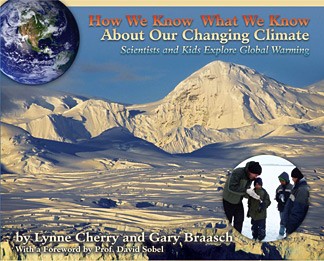Former Lab of Ornithology artist-in-residence writes climate-change book for children
By Krishna Ramanujan
In spite of troubling predictions about Earth's climate, many young people are addressing the problems in positive ways, according to Lynne Cherry, acclaimed author of 30-plus environmental books for children, whose latest book explores the science of global warming at an eighth-grade reading level.
The book, "How We Know What We Know About Our Changing Climate: Scientists and Kids Explore Global Warming" (Dawn Publications, 2008), written with photojournalist Gary Braasch, was finished during Cherry's tenure as the 2006 artist-in-residence at the Cornell Lab of Ornithology and features many examples of young people and others involved in citizen science projects at Cornell and elsewhere.
The Lab of Ornithology hosts the world's largest citizen science program, Project FeederWatch, involving more than 10,000 citizen birders who help track trends in bird populations each year. Such democratic forms of science, Cherry said, provide large-scale data that offer many clues about our changing climate.
Though a draft of the book was originally written during a 2002 residency at Princeton University, exposure to such citizen science projects at Cornell as the Nestwatch, BirdSleuth, Project Budbreak and Project FeederWatch led Cherry to revise the book with citizen science as a key theme. One section, for example, describes Stanford University ornithologist Terry Roots' climate change research, which uses citizen science data from Cornell and elsewhere to study shifts in bird migrations.
"When you go into a residency, you don't know what you are going to find, but when you are in that atmosphere of science, discovery and investigation, you are exposed to so much just by being there," Cherry said about how her residency helped shape her book in new ways.
The book, richly illustrated with numerous color photographs, mostly by Braasch, describes the work of many of the world's leading climate scientists, offers a macro look at ecology and temperature trends and suggests potential solutions and positive actions for all ages and provides resources.
The publisher offers a teacher's guide with individual lessons corresponding to topics in Cherry's book.
Cherry's time at Cornell also inspired work on another book about the ivory-billed woodpecker, which Cornell ornithologists and others reported rediscovering in 2004. The book will feature Cherry's signature artwork that appears in some of her other titles, including "The Great Kapok Tree" (1990), "A River Ran Wild" (1992), "Flute's Journey" (1997) and "How Groundhog's Garden Grew" (2003).
Currently, Cherry is producing a documentary about young people working for the environment, such as Girl Scouts in San Francisco who go door-to-door delivering compact fluorescent bulbs. The movie will focus on climate science and solutions that empower kids to reduce their carbon footprint and make a difference in the world, Cherry said.
Media Contact
Get Cornell news delivered right to your inbox.
Subscribe